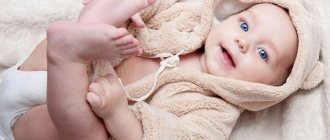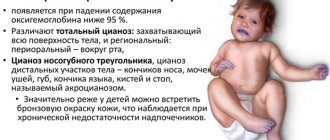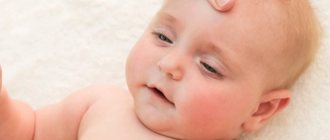Hand tremors in a 4 month old baby
Sometimes children under one year old experience involuntary muscle twitching, they are called tremors. The most common type is physiological tremor. It is characterized by involuntary contraction of the muscles of the chin, lower lip or limbs of the child and is considered a normal variant. Appears due to the immaturity of the nervous system and increased tone in children.
When symptoms worsen, neurologists call this phenomenon pathological tremor. It indicates serious disturbances in the functioning of the nervous system and is a symptom of various diseases. Hand tremors in a child may occur in the following cases:
- in times of discontent;
- while swimming;
- when changing clothes;
- when frightened, crying;
- when feeling hungry;
- during REM sleep.
As a rule, the physiological tremor of the hands in a child at 4 months already disappears, but there are cases when it can be traced up to a year. In such cases, parents need to closely monitor the child’s condition and regularly visit a neurologist.
If symptoms occur for no reason and do not go away for a long time, this may indicate the presence of pathological hand tremor in the child. Also, the child becomes more capricious and irritable than usual, and sleep deteriorates. With such symptoms, a visit to a neurologist is mandatory. The doctor will prescribe the necessary examinations, determine the diagnosis and treatment. At the Yusupov Hospital you can undergo all the necessary examinations using modern equipment under the guidance of the best specialists.
Hand tremors in a child aged 5 months and up to one year
The diagnosis and determination of the treatment algorithm is carried out exclusively by the doctor. At the Yusupov Hospital, a neurologist will determine whether the child’s tremor is physiological or pathological. Physiological tremor does not require special treatment. It is necessary to create optimal comfortable conditions for the child and regularly visit a doctor to monitor the situation. With pathological tremor the situation is different. Here the doctor may prescribe:
- baths with soothing herbs;
- relaxing massages;
- frequent air baths;
- swimming;
- general strengthening gymnastics;
- if necessary, drug therapy;
- surgical intervention in special cases, if absolutely necessary.
The causes of tremor in children can be different:
- fetal hypoxia;
- risk of miscarriage;
- umbilical cord entanglement;
- infectious diseases during pregnancy;
- stress during pregnancy;
- rapid labor;
- weak labor activity;
- prematurity;
- placental abruption;
- birth injuries.
If a child has frequent head jerks, this may indicate high intracranial pressure. If tremor persists in a 6-month-old child, you should consult a neurologist out of turn.
Hand tremors in a child aged 3 years and older
Tremor occurs due to improper development of nerve ending centers. In a stressful situation, the child’s level of norepinephrine increases, after which severe muscle tension occurs, resulting in twitching of the limbs. If hand tremor in a child aged 3 years and older is left untreated, it will progress, starting with one limb and gradually moving to other muscle groups. As a result, there is a general deterioration in the child’s condition. Neurologists at the Yusupov Hospital will help you choose an effective treatment. The doctor will conduct a diagnosis, determine the cause of the disease and prescribe treatment. At the Yusupov Hospital, complex therapy is used to treat this disease, taking into account all the individual characteristics of the child, which includes:
- electrophoresis procedures;
- regular walks in the fresh air;
- proper nutrition, adherence to the daily routine;
- physiotherapy;
- massages;
- swimming;
- if necessary, medications are added;
- surgical intervention is only in extreme cases, mainly if the cerebellum has been damaged.
After completion of treatment, it is important to maintain a daily routine at home and maintain a calm and positive atmosphere at home. Visiting a neurologist should be regular to prevent tremor. If a child over one year old has tremor, you should not self-medicate. This can lead to a worsening of the situation as a whole and is fraught with serious pathological diseases.
Why does a newborn shake?
Such a phenomenon as tremor in newborns occurs quite often and is a slight twitching of the lips, chin and limbs of the baby. Along with muscle hypertonicity, he speaks of increased excitability of the baby and the immaturity of his nervous system. These periodic muscle contractions can be observed in approximately half of all infants in the first month of life - mainly in a state of excitement: with strong crying, fear, or during the REM sleep phase (when the eyes of a sleeping toddler move very often). According to experts, the fact that a newborn shakes in the first days and weeks of his life is quite normal. However, parents should always notify their pediatrician if their infant develops tremors.
We suggest we talk about why a newborn’s chin, arms, legs and lower lip are shaking, and what should parents pay attention to in this situation?
Trembling of individual parts of the baby’s body is the result of compensatory excitation of his peripheral nervous system, which occurs in order to stabilize the condition of the child’s body. In this case, if the newborn does not shake much (i.e. the tremor is small in amplitude), but often, this is quite normal for this age. According to pediatricians, this condition occurs due to the immaturity of the nerve centers of the baby’s brain, as well as as a result of the high concentration in his blood of the hormone norepinephrine, which is responsible for the conduction of nerve impulses. Therefore, quite often the newborn’s lip, limbs and chin shake. Babies born prematurely are especially prone to tremors.
According to pediatricians, trembling in a newborn can be caused by various factors that disrupt the normal formation of his nervous system, namely:
- hypoxia during pregnancy and childbirth, causing severe disturbances in the functioning of the central nervous system and brain of the child;
- birth injuries;
- stress in the expectant mother in the last trimester of pregnancy, when a high concentration of norepinephrine in her body can destabilize the baby’s endocrine and nervous system.
Causes of tremor in a newborn: the baby’s arms, legs, chin and head are shaking
Tremor is absolutely normal for newly born babies. In some cases he talks about diseases. The symptom may simply indicate emotions; positive emotional states cause muscle tremors.
The baby is crying, his hands are shaking
This sign can also indicate abdominal cramps and fatigue.
Tremor in newborns (the causes and consequences here are incredibly varied) often occurs in response to any stress factor. For example, some children react to bathing.
Important! If a child’s arms and legs begin to shake in response to bathing, this does not mean that hygiene procedures can be abandoned.
Definition of the concept
Tremor is a symptom expressed in twitching of the muscles, chin or head. Leg tremors also occur in newborns. Trembling is often asymmetrical. For example, parts of the body may tremble separately: one leg or the chin by itself.
Newborn baby
Muscle tremors very often occur before the first month. This is an adaptation period, during which you need to protect the baby from any stress. In particular, you cannot harden your baby using air baths or do massage, since all these operations that are incomprehensible to an infant cause him anxiety.
Important ! It is necessary to monitor the child. There are more timid children, and there are also those whom even a sharp loud sound will not disturb. Therefore, the approach needs to be changed. There is no need to protect a brave baby from any factor that is negative, in the opinion of an adult, otherwise he may become fearful.
After a month, you can increase the number of procedures.
Until 3 months, shaking arms and legs are the norm. The fact is that neurons are not yet completely covered with a myelin sheath, the purpose of which is to speed up the passage of nerve signals.
Head tremors in infants
It is not uncommon for newborns or older infants to shake their heads while feeding or falling asleep. If the child feels well, there are no other symptoms, there is no cause for concern.
An adult takes care of a child
This condition is considered potentially dangerous; it is recommended to go to the doctor to make sure that the baby does not have any threatening diseases. If you have doubts about your child's health, you can do an EEG.
Hand tremors in an infant or newborn
Tremor of the limbs in newborns in most cases does not indicate any health problems.
Tremor of the chin or lips
Tremor of the chin or lips in newborns is caused by the same reasons as tremors of the arms, legs or head. As a rule, there is no reason for parents to worry.
Recommendation . Some people write “baby chin trimmer.” Correct spelling of the word "tremor".
Causes of tremor in newborns
Acne in newborns - what is it?
Why might a baby's muscles shake? Tremor in newborns can be caused by a number of conditions, both physiological and pathological.
Natural
Physiological reasons include:
- Infants have an underdeveloped nervous system. In particular, the parts of the brain responsible for movement are not fully formed.
- Too intense production of norepinephrine. This is also caused by insufficient development of the nervous system. In addition, the condition is provoked by strong emotions, as well as the inability of the adrenal glands to the life of a newborn outside the womb.
- Too long negative emotions, crying. In such a situation, the lower lip begins to shake.
Physiological causes are much smaller than those of diseases, but they cover most of the cases.
Pathological
Tremor in infants can be provoked by diseases that appear during critical periods of development: 1, 3, 9, 12 months. If during this period any illness occurs that is accompanied by tremors of the limbs, head or chin, it is important to immediately consult a doctor. This symptom may also
- Injuries during pregnancy and childbirth.
- Excessively high levels of norepinephrine “in position.” It is provoked by the mother’s nerves when she is carrying a child. If the tremors are caused by this reason, then it can last up to a year or later.
- Oxygen starvation of the fetus.
- Infectious diseases that the mother suffered during pregnancy. Even the flu is a danger.
- Difficult or excessively rapid labor.
- Hypoxia after birth.
- Drug withdrawal (caused by the pregnant woman taking illegal substances). Tremors can also occur with a hangover. If the mother often took alcoholic beverages during the prenatal period, the baby may develop an addiction. One of the manifestations of alcohol withdrawal syndrome is intense tremors.
- Increased levels of calcium, sugar, and magnesium in the body.
- Perinatal encephalopathy.
Blood poisoning may also be the cause. In addition, relatives quite often confuse this symptom with seizures. Obviously, a parent cannot figure out such a large number of reasons on his own (with the exception of a few). Therefore, you cannot self-medicate; you must consult a doctor.
When does tremors go away in infants?
Newborn screening - what is it and why?
The fact that trembling in newborns has natural causes is evidenced by its manifestation at the age of up to 3 (in extreme cases, six) months. Also, the duration cannot be too long - no more than 30 seconds.
Consequences
Metrics for newborns - what is it?
The consequences of tremor depend on the underlying disease. If this is a normal phenomenon, then it goes away on its own. If shivering is caused by perinatal encephalopathy, severe, permanent neurological damage may occur.
How to help a child
If the cause is a disease, then you should consult a doctor. If the symptom is a result of stress, then relaxing activities are sufficient.
Massage
You can perform a relaxing massage twice a day. Before doing this, you need to consult a specialist. It is not difficult to master the technique; massages are prohibited without prior training.
Massage for a baby with tremors
Exercises
You can also do special exercises aimed at relaxing muscles.
Calm environment
Creating a favorable emotional climate has a positive effect on the development of the child. Therefore, parents should not quarrel and resolve conflict situations calmly, taking into account each other’s interests.
Important to remember ! The baby becomes infected with the emotional state of the parents.
Walk
This is one of the most important things a parent can do for their baby's health. A walk helps you get rid of stress and begin to explore the world.
If the tremor is caused by pathology
The following signs should alert a parent:
- Synchronous tremor of the head, chin, arms and legs. Separately they can shake, but together it is undesirable.
- Duration more than 30 seconds. If the duration is short, we are talking about minor age-related disorders of the functioning of the nervous system. If the duration is more than 30 seconds, there may be increased seizure activity or other health problems.
- Blueness of the skin.
- The child continues to sleep and tremble, although he has already reached the age of six months.
- Difficult childbirth.
When to see a doctor
If one of the symptoms described above appears, and the baby’s hands (head, lip, chin) are simultaneously shaking, it is necessary to contact a specialist in a timely manner. In general, you need to constantly visit a pediatrician, who can quickly solve problems that arise as the baby develops.
It is clear that this is tremor of the limbs in newborns. Usually this phenomenon is not a cause for concern among relatives. It is necessary to ensure that it is well tolerated by the infant. Dr. Komarovsky also says that muscle tremors are a natural physiological phenomenon in a newborn.
Source: https://kpoxa.info/zdorovie-pitanie/tremor-konechnostej-u-novorozhdennyx.html
Tremors in infants: head, chin, lips and hands
Very often, from the first days of life, babies experience muscle cramps and tremors - the so-called tremor in newborns, which sometimes frightens parents. This may be trembling of some parts of the face (most often the chin or lower lip) or extremities (arms or legs). Less commonly, infants experience head tremor, but it already indicates serious pathologies from the point of view of neuralgia. In order to prevent danger in time and avoid the consequences of such an unpleasant phenomenon, it is important to find out its causes in time.
Typically, tremor in infants occurs due to disorders of the endocrine or nervous systems. They can appear due to problems in the mother or fetus during the prenatal period, during pregnancy, or due to some serious internal diseases. Most often, the following factors lead to this not entirely pleasant phenomenon:
- underdeveloped centers of nerve endings located in the brain and responsible for body movements;
- high concentration of norepinephrine in the blood: it occurs due to strong emotions that the baby shows (in this case, tremors in the child’s hands are most often observed, less often in the legs);
- norepinephrine can also be released in large quantities due to the fact that the upper layer of the baby’s adrenal glands is unadapted to life outside the womb;
- hysteria, crying for too long: this condition most often causes tremor of the lower lip in newborns;
- serious problems (diseases) during critical periods of development of the baby’s first year of life: they occur in the 1st, 3rd, 9th, 12th months: for any deviations and the simultaneous appearance of tremor, consultation with a neurologist is necessary;
- trauma to the baby’s nervous system during childbirth or even during its intrauterine development (therefore, pregnant women are contraindicated in any excitement that entails a surge of the same norepinephrine) - usually in this case, the child’s tremor does not go away for a very long time or appears after a year ;
- oxygen starvation of the fetus;
- infection suffered by the mother (even the flu);
- weakness of labor;
- rapid labor;
- umbilical cord entanglement;
- placental abruption;
- hypoxic-ischemic encephalopathy is a serious brain disorder caused by hypoxia;
- drug withdrawal syndrome, when a pregnant woman stops taking potent psychotropic substances, drugs, alcohol;
- hyperglycemia - increased glucose levels in the baby’s blood;
- hypocalcemia - low calcium content in the baby’s blood serum;
- hypomagnesemia - accordingly, a reduced content of magnesium ions;
- sepsis - infectious blood poisoning;
- intracranial hemorrhage.
Parents cannot independently determine the causes of this phenomenon, so in this case the help of specialists is necessary. If your newborn's chin (or limb) tremor goes away quickly (within one to two weeks), there is nothing to worry about. If trembling of various parts of the body lasts more than a month and does not go away, you should definitely consult a doctor. If there is a head tremor in a child under one year old, you should not wait a day, as this may indicate a serious nervous disorder. In this case, a specialist can prescribe appropriate treatment.
Sometimes even limb tremors in newborns may require treatment, despite otherwise normal development. It is carried out under the supervision of a specialist, and most often helps to improve the baby’s health. In addition to regular monitoring by a neurologist and strict adherence to his medical recommendations, you will need to:
- give your baby a relaxing massage - this should be entrusted to a specialist; this event is prescribed if hand tremors in children do not go away for a long time;
- conduct therapeutic exercise classes;
- arrange soothing baths with medicinal herbs;
- go swimming;
- provide the child with a calm and friendly environment;
- If a child continues to have chin tremor after a year, drug treatment is prescribed with antihypoxants - drugs that improve oxygen access to tissues.
Causes and treatment of tremor in newborns
Tremors in newborns are muscle spasms that occur in children from the first days of life. In most cases, trembling of the limbs manifests itself as cramps of the arms, legs and chin. Rarely, head tremors are observed, indicating serious neurological problems. At the same time, tremor in a newborn’s arms, legs and chin is not considered a pathology.
Causes of tremor in newborns
The cause of tremor in newborns is the underdevelopment of the centers of nerve endings, which are located in the brain and are responsible for the movement of the body. The appearance of tremor is facilitated by a high concentration of norepinephrine in the blood, which manifests itself when the baby is emotional. The release of a large amount of this secretion occurs due to the unadaptability of the upper layer of the newborn's adrenal glands to living conditions outside the womb.
In pediatrics, there is a concept about the critical time of development of a newborn outside the womb; this also applies to the development of the baby’s nervous system. During this period, the nerves are most sensitive and even a slight deviation from the norm can cause serious pathology. The critical period is considered to be the first, third, ninth and twelfth months of a child’s life. At this time, it is very important to closely monitor the health and general condition of the child and, for the most minor problems, contact a specialist - a neurologist.
If the tremor in a newborn does not go away on its own or appears later, then the doctor can make a diagnosis that is directly related to trauma to the nervous system during fetal development or during childbirth. There are many reasons for such a pathology. A slight excitement of the mother carrying a child can have a detrimental effect on the formation of the fetal nervous system. During times of anxiety and excitement in the mother, the concentration of norepinephrine in her blood increases, causing trembling of the limbs, chin or head in the newborn. Oxygen starvation of the fetus during pregnancy or lack of oxygen during childbirth can also become a provoking factor in the development of tremor.
Oxygen deficiency can develop against the background of a violation of the integrity of the fetal membrane due to hemorrhage or the threat of miscarriage; the pathology can be associated with an infection suffered by the mother, weakness of labor, rapid labor, entanglement of the umbilical cord, and placental abruption. These factors contribute to the disruption of oxygen supply to the baby’s brain, causing oxygen starvation. Oxygen deficiency subsequently leads to tremors in newborns. Children born prematurely also often experience trembling of the limbs and chin due to the unpreparedness of their nervous system for life outside the womb. The further development of the child (after his birth), even in conditions of clean air, does not compensate for the oxygen starvation of the fetus.
Treatment of tremor in newborns
Treatment of tremor in newborns, even with normal child development, must be carried out under the supervision of a specialist. Parents of such a baby should think about a possible deviation, which requires constant attention from a neurologist. Timely and correctly selected treatment of the child’s nervous system helps to normalize and strengthen the health of the newborn. In addition to constant monitoring of the child’s health by a pediatric neurologist and following his recommendations, it is important to give the child a relaxing massage, therapeutic exercises, swimming, and surround the child with a calm and friendly environment.
Author of the article:
Mochalov Pavel Alexandrovich |
Doctor of Medical Sciences therapist Education: Moscow Medical Institute named after. I. M. Sechenov, specialty - “General Medicine” in 1991, in 1993 “Occupational diseases”, in 1996 “Therapy”. Our authors
Tremor in infants
In newborns, you can often notice small twitching of the limbs and chin.
Such muscle contractions are observed in 50% of children during the first weeks of life. They occur after strong emotional arousal during: intense crying, severe fear, REM sleep. The nervous system of a newborn is immature, so he is overly excitable and makes some uncontrollable movements. Such tremor is considered normal, but in any case, the pediatrician should be aware of it. The tremor, frequent in intensity and small in amplitude, that accompanies crying is a physiological feature of the child’s nervous system. This is how the body compensates for the excitement and stabilizes the condition.
Frequent and small tremors are natural for an immature nervous system. But if they do not go away by 3 months and appear for no reason, then you need to think about dysfunction of the nervous system.
There is another reason for tremor - high levels of norepinephrine in the blood of newborns. This adrenal brain hormone responds to the transmission of nerve impulses to the brain. It is the high concentration of norepinephrine in the blood that provokes a sharp contraction of muscles during strong emotional stress.
Tremors can be triggered by various factors that interfere with the normal development of the baby before and after birth. Experiences, stress of a pregnant woman, and poor environmental conditions negatively affect the formation of the central nervous system. After birth, tremor occurs against the background of poor living and psychological conditions.
Tremors in infants usually appear on the chin and limbs. In rare cases, the shaking affects the entire head.
Head tremors can be an absolutely safe phenomenon during the first months of life. But more often it serves as a signal indicating a serious neurological disease. It is especially dangerous to leave a baby without medical care if the manifestations of tremor are intense, occur for no reason and do not subside for a long time.
The cause of the development of head tremor in an infant can be: drug withdrawal syndrome, hypoxic-ischemic encephalopathy, hypocalcemia, hyperglycemia, hypomagnesemia, sepsis, intracranial hemorrhage.
Do not be alarmed by the small and frequent trembling of the newborn's chin if he is emotionally excited. Tremor is caused by immaturity of the nerve center of the brain. But if the attacks are too intense and prolonged in time and, in addition, the limbs and head tremble, then medical attention is urgently needed.
Also, trembling of the chin, accompanied by frequent regurgitation, anxiety, and sleep disturbances, are signs of muscular dystonia.
Hand tremors are as harmless as chin tremors. But only up to a certain time, after 3 months, non-derivative small muscle contractions are not considered normal and require treatment.
Additional symptoms should alert a young mother. For example, hand tremors combined with insomnia, increased sweating, diarrhea and abdominal pain are most likely a sign of thyroid dysfunction. The exact diagnosis will be determined after visiting an endocrinologist and completing all the necessary tests.
Tremor of the legs in infants is observed less often than contraction of the muscles of the chin and arms. But this is still the same harmless passing sign of the immaturity of the baby’s body. Leg tremors often appear in premature babies who have suffered hypoxia and trauma during childbirth.
But if the legs tremble very much and the tremors do not stop by 3 months, then only a doctor can help. Therapeutic massage, gymnastics and swimming are great help, everything that strengthens the leg muscles and nervous system. If the tremor appears for the first time, you need to make sure that it is not a seizure.
In rare cases, involuntary muscle contractions are caused by improper structure of individual parts of the leg or injury.
Sometimes the symptoms accompanying leg tremors can indicate a more serious illness. A qualified specialist must diagnose the disease and prescribe treatment.
Tremors that occur exclusively during fear, crying, and rapid sleep do not require treatment. But if it does not decrease and does not go away by 3 months, you need to contact a neurologist. It is especially important to consult a doctor in case of causeless and increasing tremor.
Serious neurological disorders require drug correction, and in other cases, therapeutic massage, special gymnastics, swimming in the pool, and adherence to a rational daily routine are prescribed.
The mental balance of the people surrounding the baby and strict adherence to all the doctor’s recommendations guarantee a complete cure, with the exception of children in extremely serious condition.
TRADITIONAL MEDICINE Traditional treatment of adenoids more...
How long should a child sleep? Main more...
Tremor in infants is most often twitching of the arms and chin. Similar to muscle hypertonicity, tremor is considered a sign of a lack of sufficient maturity of the baby’s nervous system and its significant excitability.
Most often, muscle contractions in newborns are recorded periodically during severe fright, screaming, crying, REM sleep (with noticeable eye movements) or feelings of hunger.
If the intensity of tremor in newborns is high and the amplitude is small, then these are the characteristics of the nervous system of the newborn.
Tremor is a fairly common phenomenon, occurring in approximately half of newborns, and is considered normal in the first months of life (by 3-4 months all signs of tremor should disappear).
Tremor in children under one year old
From the first days of life, a newborn child tends to make sudden, spontaneous movements. If we are talking about the first-born, such a condition can quite frighten mom and dad, since they have not yet learned to distinguish a normal condition from a pathological one. One such manifestation is tremor in newborns.
Tremor is systematic twitching of the arms and legs, chin, and in rare cases the head. Muscle hypertonicity is often observed (this is also considered normal in infants). All this together should not cause alarm, as it is explained by the immaturity of the baby’s nervous system. Therefore, an excited state is observed in almost every second newborn, usually during crying.
Tremors of the lower and upper extremities, as well as tremors of the chin or lips, are more common in premature babies. The head rarely trembles due to underdevelopment of brain structures with centers of nerve endings. The severity of the clinical picture is complemented by an increased level of norepinephrine, an adrenal hormone contained in the blood.
Until 3 months, while the nervous system develops and strengthens, tremor in newborns is not considered something out of the ordinary. Although these children need to be monitored closely, no special treatment is required.
Causes
Seizures in a newborn do not appear out of the blue. However, not all the causes that cause them are dangerous. Some are even physiological. Let's look at the main ones.
- Underdevelopment of the nervous system. As noted earlier, the central nervous system during birth is not able to perform all the functions assigned to it, which causes convulsions in newborns in the form of twitching. In addition, the adrenal glands with their nerve centers are also at the stage of final formation. They are responsible for the release of increased amounts of norepinephrine into the blood, and this is another reason for trembling of the hands and other parts of the body.
- Premature birth. Premature birth always becomes a test for the baby, because it is much more difficult for him to adapt to the big world outside the mother's womb. Although all parts of the nervous system have already been formed, the pathways still need time to mature. So certain disruptions occur in the form of tremors, weak muscle tone, weakened sucking reflex, etc.
- Hypoxia. Even when the child is in the womb, there is a risk of developing oxygen starvation due to previous infection, polyhydramnios and threats of miscarriage. And childbirth is generally a traumatic process, accompanied by enormous pressure on the fetal brain. Lack of oxygen contributes to the development of twitching.
Births that take place between 28 and 37 weeks are considered premature. The nervous system, like the entire body, is not yet ready for birth; baby needs extra help and care
Symptoms
The clinical manifestations of tremors in a one-month-old baby are quite varied. More often than other parts of the body, the lower lip twitches along with the chin. Hand shaking occurs much less frequently.
A possible variation of physiological tremor is its asymmetry, that is, one arm and one leg twitch. With symmetrical trembling, the twitching is mild, all movements are of small amplitude and rhythmic. This condition lasts for several seconds, occurring spontaneously or after nervous stress: bathing (in the case when the baby does not like the procedure) or ordinary crying.
If your child has these symptoms, no treatment is required. Concerns should arise when tremor does not disappear after the first trimester of life, but its intensity, on the contrary, increases. In cases where spontaneous sudden movements persist for no apparent reason, be sure to see a neurologist.
Dangerous convulsions
Convulsions in a newborn may not be so harmless and indicate the development of a serious disease of the nervous system. But in a serious illness, convulsive syndrome is far from the only symptom.
Muscle hypertonicity, impaired coordination of movements, developmental delays, frequent regurgitation, etc. may be observed.
In children under one year of age, the following diseases cause seizures:
- metabolic disorders (lack of calcium, magnesium, low blood glucose concentration, increased bilirubin);
- impaired metabolism of amino acids, vitamins, fats or carbohydrates;
- increased intracranial pressure;
- encephalopathy of the hypoxic type;
- cerebral hemorrhage;
- sepsis.
In infants, convulsive syndrome is more accompanied by motor activity than in newborns.
High fever during illness can cause febrile seizures in young children.
Another dangerous type of seizure is febrile. They occur during infectious diseases (ARVI, pneumonia, otitis media) accompanied by fever.
Their appearance is the body’s reaction to high temperature in children aged 6 months to 3 years.
If a child at the age of 1 had similar attacks against a background of fever, before the age of 2, such children are recommended to bring down even a low body temperature within 37.5 oC.
The connection between tremor and the appearance of teeth
When the baby's teeth erupt one after another, the baby experiences discomfort previously unknown to him. The places where the teeth peck hurt and itch, so the child is often capricious with or without reason, while being in a state of nervous excitement. Due to such circumstances, tremor can be directly related to tooth growth.
https://www.youtube.com/watch?v=yKe_mQJDa24
To relieve pain, use special gels with a cooling and analgesic effect. Among them are Dentinox, Dentol baby, Kalgel, Baby dent drops.
Treatment options for tremor
First of all, we note that it is a specialist in the field of neurology who determines whether infant tremor needs to be treated. All actions and treatment methods are aimed at calming and relaxing the nervous system. If there is a convulsive syndrome due to neurological diseases, medications are included in the treatment regimen.
The doctor may recommend taking baths with decoctions of lemon balm, valerian or mint, which are done every other day (taking herbal baths too often can provoke an allergic reaction). In addition, relaxing massages, therapeutic exercises and swimming are recommended - everything that relieves muscle tone.
How to give a massage
The first massage courses are carried out no earlier than 5 weeks of the child’s life. The baby is placed on a hard surface. The room, on the one hand, should be fresh, on the other, not cold. It is recommended to start performing movements 30-40 minutes after eating. The best time of day is the first half of the day.
Every mother needs to master basic massage techniques.
Before the procedure, hands are washed thoroughly, palms are rubbed to keep them warm. According to safety precautions, in order not to injure the baby, rings and bracelets are removed from the mother (massage therapist), and nails must be trimmed short. A familiar environment, such as your own room, and the absence of sunlight on your face will make the procedure more comfortable and enjoyable.
The basic rule: all movements are carried out from the edge to the center, for example, from the foot up to the groin area, from the toes to the shoulder, etc.
Massage techniques include:
- stroking;
- trituration;
- vibration movements;
- kneading.
A massage always begins with stroking. They activate the muscular system and at the same time relax the body. Then they begin rubbing and kneading: each part of the body is massaged with spiral movements, which causes blood flow to the tissues and organs, saturating them with oxygen.
Vibratory movements include patting, rocking and chopping. Typically used for back massage. However, the kidney and spine area is not subject to such manipulations. The massage session also ends with stroking.
Before going to bed, it is recommended to do several calming exercises:
- "Watch." The tummy is stroked clockwise for 5 minutes. Exercise is especially useful for intestinal colic.
- "Hammer". The baby is lying on his back. The foot is taken in one hand, and the other side is lightly tapped with a fist, as if with a hammer. The same is done with the second leg.
- "Toptyzhkin." Starting position: on your stomach. A toy is placed in front of the baby. When he reaches for it, the muscles of the back and neck are activated. At this time, the buttocks are kneaded with fists.
- "Herringbone." Stroking movements are made at an angle relative to the spine, starting from the back and ending with the tailbone.
- "Geese and chickens." Light pinching of the skin of the back, large and small, is performed. At the same time, you can tell a fairy tale about how the geese came out to nibble grass, chickens joined them, etc.
So, tremor in infants is a common phenomenon and quite understandable from a physiological point of view. However, if you notice any deviations in your baby’s behavior or the trembling does not go away over time, but becomes more intense, see a specialist.
Source: https://floragaz.ru/zdorovye/tremor-detey-do-goda
Causes of tremors in infants
The most common causes of tremor can be:
- immaturity of the nervous system;
- fetal hypoxia;
- premature birth.
In the first weeks of a baby’s life, he lacks coordination of movements, and the nervous system is immature. These factors cause limb tremors in newborns.
Muscle hypertonicity also increases the likelihood of tremors. Also, during the manifestation of emotions, an increased level of norepinephrine may be observed in the baby’s blood.
During pregnancy and during childbirth, there is a risk of disturbances in placental blood flow, which can negatively affect processes in the brain. Hypoxia can be a consequence of:
- intrauterine infection;
- dysfunction of the placenta;
- bleeding;
- increased uterine tone (threat of miscarriage);
- polyhydramnios.
Problems with the child’s nervous system can be caused by both rapid labor and weak labor, as well as placental abruption and
entwining the fetus with the umbilical cord.
The above factors impede the access of oxygen to the brain, which leads to tremor of the arms, legs and chin in newborns.
A premature baby is most often susceptible to tremors of the lips, legs or chin.
This happens because their nervous system, in principle, is not mature. She has to complete her formation outside the mother’s womb, where there are no and cannot be any conditions close to her, even in the case of adequate and careful care.
Tremor in newborns, causes and consequences, Komarovsky, reviews (forum)
Tremor in infants is most often twitching of the arms and chin . Similar to muscle hypertonicity, tremor is considered a sign of a lack of sufficient maturity of the baby’s nervous system and its significant excitability.
Most often, muscle contractions in newborns are recorded periodically during severe fright, screaming, crying, REM sleep (with noticeable eye movements) or feelings of hunger.
If the intensity of tremor in newborns is high and the amplitude is small, then these are the characteristics of the nervous system of the newborn.
Tremor is a fairly common phenomenon, occurring in approximately half of newborns, and is considered normal in the first months of life (by 3-4 months all signs of tremor should disappear).
Chin tremor in a newborn under 1 year of age is also rarely a cause for concern and does not require treatment, since it is often a benign, age-related, specific condition of the nervous system.
However, if parents notice a tremor in a child, it is better to consult a pediatrician.
The baby’s nervous system is very flexible and very susceptible to external influences, so proper treatment can easily normalize and restore it.
Causes of tremors in infants
The most common causes of tremor can be:
- immaturity of the nervous system;
- fetal hypoxia;
- premature birth.
Immaturity of the nervous system
In the first weeks of a baby’s life, he lacks coordination of movements, and the nervous system is immature. These factors cause limb tremors in newborns.
Muscle hypertonicity also increases the likelihood of tremors. Also, during the manifestation of emotions, an increased level of norepinephrine may be observed in the baby’s blood.
Fetal hypoxia
During pregnancy and during childbirth, there is a risk of disturbances in placental blood flow, which can negatively affect processes in the brain. Hypoxia can be a consequence of:
- intrauterine infection;
- dysfunction of the placenta;
- bleeding;
- increased uterine tone (threat of miscarriage);
- polyhydramnios.
Problems with the child’s nervous system can be caused by both rapid labor and weak labor , as well as placental abruption and entanglement of the fetus with the umbilical cord. The above factors impede the access of oxygen to the brain, which leads to tremor of the arms, legs and chin in newborns.
Premature birth
A premature baby is most often susceptible to tremors of the lips, legs or chin.
This happens because their nervous system, in principle, is not mature. She has to complete her formation outside the mother’s womb, where there are no and cannot be any conditions close to her, even in the case of adequate and careful care.
What parents can do
Parents can take a number of measures aimed at reducing the number of twitches and preventing their occurrence:
- The most important condition for combating tremor is to create a comfortable environment and peace for the baby. All activities related to caring for a newborn baby (feeding, bathing, swaddling, walking, and so on) must be carried out measuredly, without unnecessary fuss, creating the most favorable and calm atmosphere for them.
- A very good help in this event will be a relaxing massage, which, after a short course of training, parents can easily perform on their own at home.
- Herbs added to the bath (chamomile, lemon balm, oregano, valerian, mint, motherwort) perfectly relieve tension and relax the nervous system. But, given the risk of allergic reactions, using herbs more than three times a week is not recommended.
- For calm, measured functioning of the body, it is extremely important to follow a daily routine. In more severe cases, the pediatrician and neurologist may prescribe medications that improve oxygen supply to the brain (Mydocalm, Glycine).
In any case, you cannot do without visiting a neurologist, and it is especially important to get advice from a specialized doctor when the child is three, six and nine months old..
During these periods, children experience the most intensive growth and development of the central and peripheral nervous systems, therefore, during these periods, the appearance of various neurotic pathologies is most likely.
In addition to the above periods, contacting a neurologist is also necessary in cases where certain symptoms occur:
- when the trembling does not go away after the child reaches six months of age; trembling of the chin and hands continuously lasts more than thirty seconds and occurs in a calm environment for no apparent reason;
- simultaneously with twitching of the arms and chin, a tremor of the head is observed, the trembling is characterized as large, literally “pounding”;
- during an attack, cyanosis (cyanosis) and perspiration appear on the baby’s skin;
- tremor appears continuously for several weeks in a row; pregnancy and childbirth occurred with a complicated history, which could lead to damage to the newborn’s brain as a result of oxygen starvation.
Having identified the pathologies that lead to twitching, the doctor prescribes treatment and, as a rule, the child’s condition quickly returns to normal, but only if all the prescriptions and recommendations of the specialist are strictly followed.
https://www.youtube.com/watch?v=sw3IEwnZ0_I
Tokareva Larisa, pediatrician
12, total, today
( 177 votes, 4.53 out of 5)
In what cases is targeted treatment necessary?
If signs of tremor are observed for longer than 3 months, spread to the legs and head, and are not associated with the characteristics of the nervous system or a feeling of hunger, then this should cause alarm among parents.
This may result in:
- intracranial hemorrhage;
- hyperglycemia;
- hypocalcemia;
- hypoxic-ischemic encephalopathy;
- hypomagnesemia;
- drug withdrawal syndrome;
- sepsis and increased intracranial pressure.
Targeted treatment of tremor in newborns is mandatory after a traumatic brain injury or infectious disease.
In such cases, systematic observation should be carried out by a pediatric neurologist.
When is it time to see a doctor?
Do not be afraid that the baby needs the consultation of a specialist such as a neurologist. Moreover, regular visits to his office, even for children without any obvious signs, are a necessity today.
After all, even prescribing vitamins for general strengthening becomes good support for the whole body and helps the baby’s development. At the appointment, the doctor will be able to determine what is considered suspicious in the child’s behavior. And conclusions should be drawn no earlier than 3-6 months. After all, until this time, the baby may still have postpartum consequences.
The following conditions may be cause for concern at this age:
- The lower jaw shakes if the baby is sleeping, calm, motionless;
- Tremor is also observed in the cervical region (mobility of the entire head);
- There is blueness on the skin, sweat appears;
- During the birth process there were problems associated with a protracted period, hypoxia, and prematurity.
Treatment methods
The treatment method for tremor of the arms, legs, and head in a child is aimed at restoring the health of the baby in general and the nervous system in particular.
The recommendations of a pediatric neurologist should be strictly followed.
Massage for tremors in infants
In addition, parents definitely need to create a pleasant, cozy and friendly environment around their baby, systematically massage their baby (it promotes relaxation), instill swimming skills (this is possible even in a home bath), and do therapeutic exercises with him.
Such efforts of parents will not be in vain.
The easiest way to master massage techniques for newborns (from the age of 5-6 weeks) at home. The pediatrician will definitely teach mom and dad basic massage movements, based on which you can then proceed to perform a variety of exercises.
The basic massage movements are:
Source: https://MemorySafonovo.ru/diagnostika/tremor-u-novorozhdennyh-prichiny-i-posledstviya.html
In what cases is targeted treatment necessary?
If signs of tremor are observed for longer than 3 months, spread to the legs and head, and are not associated with the characteristics of the nervous system or a feeling of hunger, then this should cause alarm among parents.
This may result in:
- intracranial hemorrhage;
- hyperglycemia;
- hypocalcemia;
- hypoxic-ischemic encephalopathy;
- hypomagnesemia;
- drug withdrawal syndrome;
- sepsis and increased intracranial pressure.
In such cases, systematic observation should be carried out by a pediatric neurologist.
Treatment methods
The treatment method for tremor of the arms, legs, and head in a child is aimed at restoring the health of the baby in general and the nervous system in particular.
The recommendations of a pediatric neurologist should be strictly followed.
In addition, parents definitely need to create a pleasant, cozy and friendly environment around their baby, systematically massage their baby (it promotes relaxation), instill swimming skills (this is possible even in a home bath), and do therapeutic exercises with him.
Such efforts of parents will not be in vain.
The easiest way to master massage techniques for newborns (from the age of 5-6 weeks) at home. The pediatrician will definitely teach mom and dad basic massage movements, based on which you can then proceed to perform a variety of exercises.
The basic massage movements are:
An important role is played by the baby’s psychological mood and his physical comfort during the massage:
- The room needs to be ventilated, this will take 20-30 minutes (if the weather is warm outside, then the massage can be performed with the window open);
- Hands must be dry, bracelets and rings must be removed, nails must be trimmed;
- Before starting the massage, you should shake your hands and rub your palms together so that they become warm;
- The massage session is carried out during the baby’s active waking hours; it is always necessary to ensure that he is in a good mood. If the mood deteriorates, you need to stop for a while, cheer up the child and you can continue;
- The place where the massage is performed should be familiar to the baby; it is convenient to do it on the changing table;
- Nothing should disturb the child, for example, the sun shining in his eyes;
- When doing a massage, it is useful to talk with the baby, smile, sing songs, it is better if the facial expressions are emotionally rich;
- Massage is always accompanied by stroking;
- There is no need to use aromatic oils or powder so as not to clog delicate pores (it is better to use regular products used for daily moisturizing for massage purposes);
- The highest effect of massage is observed before water procedures;
- Movements should be smooth. The massage begins with the face: in this case, it is necessary to stroke the baby along the edges and along the wings of the nose.
How tick-borne borreliosis manifests itself - symptoms and signs that will leave no doubt.
Is it possible for newborns to use the medicine Diacarb? We have collected reviews from doctors and patients, contraindications and indications for the medication in one review.
Here are some basic exercises:
conclusions
Pediatrics operates with the concept of a critical time for a child’s development after birth, especially with regard to the nervous system, disturbances in the functioning of which can cause tremors in newborns.
The 1st, 3rd, 9th and 12th months of a baby’s life are considered critical periods, when nerve endings are highly sensitive and any deviation from the norm can lead to the development of certain pathologies.
To prevent the development of serious problems that may be causing tremors, systematic monitoring of the child’s health is strongly recommended. If you notice signs of tremor in a newborn, there is no need to panic, but you should definitely contact a neurologist.
head tremors in newborns
Tremor in infants is most often twitching of the arms and chin . Similar to muscle hypertonicity, tremor is considered a sign of a lack of sufficient maturity of the baby’s nervous system and its significant excitability.
Most often, muscle contractions in newborns are recorded periodically during severe fright, screaming, crying, REM sleep (with noticeable eye movements) or feelings of hunger.
If the intensity of tremor in newborns is high and the amplitude is small, then these are the characteristics of the nervous system of the newborn.
Tremor is a fairly common phenomenon, occurring in approximately half of newborns, and is considered normal in the first months of life (by 3-4 months all signs of tremor should disappear).
Chin tremor in a newborn under 1 year of age is also rarely a cause for concern and does not require treatment, since it is often a benign, age-related, specific condition of the nervous system.
However, if parents notice a tremor in a child, it is better to consult a pediatrician.
Tremor of which organs is most often present in infants?
Most often, newborns experience:
- head tremor (cause – immaturity of the nervous system);
- tremor of the arms (less often legs), chin and lips (cause – prematurity).
Basic exercises
Here are some basic exercises:
- "Hammer" . When the child is lying on his back, you need to clasp the right foot with one hand and tap the outside of the leg from bottom to top with the fist of the other. Next, the exercise is repeated with the foot of the other leg.
- “Stroking our hands . The baby's arm is fixed with the left hand, and the right hand gently clasps the shoulder. When lowering to the wrist, you should make shaking movements. Do the exercise 2-3 times and move on to the other hand. Using similar tactics, you can perform the “Stroking the Legs” exercise.
- "Watch" . Exercise also helps children with intestinal problems. The baby's tummy should be stroked clockwise for 5-7 minutes.
- "Toptyzhka" . The baby lies on his tummy, and the masseur gently kneads his buttocks with his fists. To keep your baby occupied, it is recommended to place a bright, interesting toy in front of him. He will look at her, reach for her, and thus the back and neck muscles will be activated.
- "Herringbone" . In the direction from the back to the coccyx and at an angle to the spine, it is necessary to make stroking movements.
conclusions
Pediatrics operates with the concept of a critical time for a child’s development after birth, especially with regard to the nervous system, disturbances in the functioning of which can cause tremors in newborns.
The 1st, 3rd, 9th and 12th months of a baby’s life are considered critical periods, when nerve endings are highly sensitive and any deviation from the norm can lead to the development of certain pathologies.
To prevent the development of serious problems that may be the cause of tremors, systematic monitoring of the child’s health is strongly recommended. If you notice signs of tremor in a newborn, there is no need to panic, but you should definitely contact a neurologist.
: Massage and exercises for babies
Features of massage and morning health exercises for newborns. What you should know and do.
source
Tremor in newborns: trembling of the limbs and beard. Komarovsky's advice
The term “tremor” refers to involuntary and uncontrollable rhythmic contractions of muscles in any part of the body. In babies before the first month of life, tremor occurs in half of the cases and is often a normal physiological phenomenon.
However, many young and inexperienced parents find it difficult to distinguish developmental deviations from awkward, poorly controlled, but absolutely normal movements of the baby.
Therefore, it is important to know when the phenomenon is pathological and whether it is worth sounding the alarm if you find a tremor in your baby.
Tremors of legs and arms, head and face, chin and jaw
This phenomenon can be classified according to the location of the tremor:
- Tremor of the limbs. It manifests itself as rhythmic twitching of the arms and legs, often occurring due to severe stress (fear, prolonged crying, colic, etc. irritants). In most cases it is of a physiological nature.
- Tremor of the head, face. Most often, trembling of the lower lip and eyebrows is observed. If a tremor of the entire head occurs, there is reason to suspect a serious pathology of a neuralgic nature.
- Tremor of the chin and jaw. It also often has a physiological nature.
Experts also divide tremor into:
- physiological. The phenomenon is considered normal for babies from birth to 4 months. It is distinguished by rapidly passing bursts of tremors and occurs due to a stressful situation. With this type, special treatment is not required, since the tremor goes away on its own.
- pathological. It can occur for no reason, has a more pronounced and prolonged course, and the general condition of the baby worsens. Without special treatment it can progress. This type of tremor is only a symptom of a dysfunction of the central nervous system and is often accompanied by other signs (increased or decreased muscle tone, strabismus, asymmetry and other abnormalities).
Important! With the pathological nature of tremor, the main cause may be such dangerous conditions as cerebral hemorrhage, intracranial hypertension and others. Therefore, it is important to seek medical advice as soon as possible!











